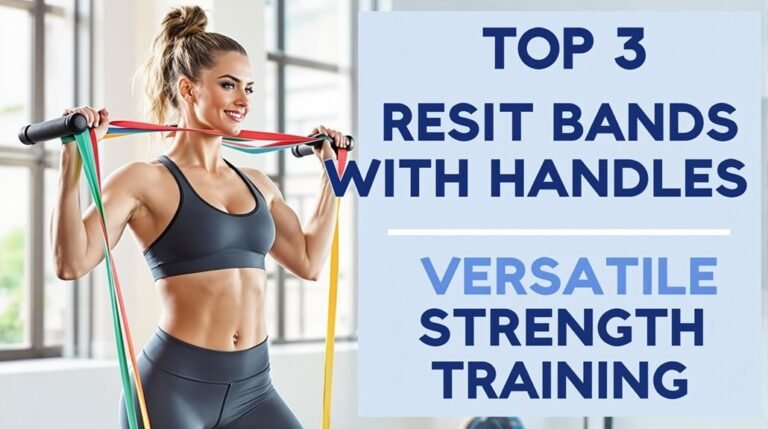Water-filled aqua bags offer a unique approach to resistance training that you'll find gentler on your joints than traditional weights. They use water's natural movement to create dynamic resistance, engaging more muscle groups during each exercise. You can choose from various sizes (7-20kg) and shapes, with crescent designs ideal for squats and teardrop shapes perfect for swings. To start, focus on proper form with 60% intensity, gradually increasing by 5% weekly. Always maintain core engagement and proper spacing during workouts. Understanding the four fundamental lifting methods – stable, rhythm, collision, and tilt – will reveal the full potential of your aqua bag training.
Key Takeaways
- Water-filled aqua bags provide variable resistance through fluid movement, creating an unstable load that engages more muscles than traditional weights.
- Size options range from 7-20kg, with different shapes for specific exercises: crescents for squats, teardrops for swings and strikes.
- Core engagement is crucial during exercises due to water's constant movement, improving balance and stability across all movements.
- Four fundamental lifting methods (stable, rhythm, collision, tilt) form the basis of effective aqua bag training techniques.
- Start at 60% intensity focusing on form, progress by 5% weekly, and include recovery weeks at 50% intensity every fourth week.
Understanding Dynamic Water Resistance Training
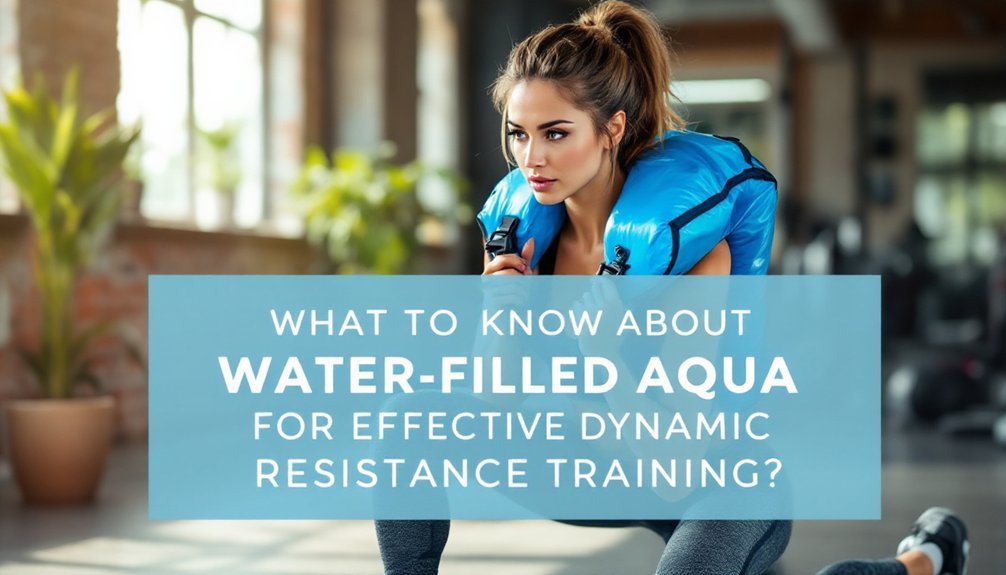
While traditional resistance training relies on weights and machines, dynamic water resistance training harnesses the unique properties of water to create an effective full-body workout. The principles of water buoyancy and resistance dynamics work together to provide a unique training environment that's gentle on your joints while challenging your muscles.
You'll find that water's natural properties offer variable resistance based on your movement speed and depth. When you move faster, you'll experience more resistance, allowing you to control workout intensity naturally. The resistance dynamics create an all-encompassing training environment where multiple muscle groups work simultaneously, improving both strength and coordination. Plus, the water's buoyancy supports your body weight, making this type of training especially beneficial if you're recovering from injury or looking for low-impact exercise options. This form of exercise has proven particularly effective for cardiovascular health and endurance, as it engages muscles in both concentric and eccentric phases of movement. Additionally, using top exercise mats can enhance your comfort and stability during workouts, further optimizing your training experience.
Benefits of Aqua Bag Workouts
Your core muscles will get markedly stronger with aqua bag training, as the shifting water forces your stabilizing muscles to work continuously throughout each movement. The full-body movements required in aqua bag exercises enhance your overall strength and coordination, while also improving your balance through the constant need to adjust to the water's motion. The dynamic resistance of water-filled bags provides excellent joint stability benefits, as the fluid motion creates a gentler impact on your joints compared to traditional weights while still delivering an effective workout. These versatile bags are perfect for HIIT workouts and can be seamlessly integrated into various training sessions. Additionally, the use of anti-burst features in stability balls ensures safety during exercises, making aqua bags a complementary tool for core strengthening.
Core Strength Development
Training with aqua bags delivers exceptional core strength benefits that traditional weights simply can't match. The dynamic water resistance forces constant core engagement and enhanced muscle recruitment throughout each movement, helping you develop stronger, more stable core muscles. Dynamic resistance training promotes superior motor control through natural movement feedback during exercises.
| Core Area | Training Benefit | Exercise Example |
|---|---|---|
| Deep Core | Stability Control | High Plank Hold |
| Obliques | Rotational Power | Side Bends |
| Lower Back | Injury Prevention | Good Mornings |
| Abdominals | Strength Building | Crunches |
| Hip Flexors | Balance Control | Standing Lifts |
You'll notice immediate improvements in your balance and stability as the shifting water weight challenges your body to maintain proper form. This unpredictable resistance mimics real-life movements, making aqua bag training particularly effective for developing functional core strength you can use in everyday activities.
Full-Body Movement Enhancement
Unlike traditional weights, aqua bags revolutionize your workout by engaging multiple muscle groups simultaneously through dynamic resistance. You'll experience enhanced balance training as the water's constant movement challenges your stability during exercises like lunges, squats, and swings. The responsive resistance movement simulates realistic opponent interactions during boxing drills.
These versatile tools boost your muscle activation through various training methods, from HIIT workouts to flowing sequences. You can easily adjust the weight by adding or removing water, making them perfect for progression in your fitness journey. Whether you're performing functional movements that mirror daily activities or engaging in sport-specific training, aqua bags help identify and correct muscle imbalances while improving coordination. Their portability means you can train anywhere, and their low-impact nature makes them suitable for rehabilitation exercises and injury prevention.
Joint Stability Advantages
While traditional weights can place significant stress on joints, aqua bags offer unique stability advantages that protect and strengthen your body's connective tissues. The dynamic resistance of water creates a more forgiving workout environment, reducing the risk of joint injuries while still providing effective resistance training. The sloshing effect of water actively minimizes strain on joints and tendons during movement.
Here's how aqua bags enhance joint stability and prevent injuries:
- The water's constant movement forces your core to engage continuously, improving active joint stability throughout your body
- Water's fluid nature distributes weight more evenly across joints and tendons, minimizing stress points during exercises
- The gentle, absorbing properties of water-filled bags provide immediate feedback on your form, helping you maintain proper alignment
These benefits make aqua bags particularly valuable for rehabilitation and long-term joint health maintenance.
Choosing Your Perfect Aqua Bag
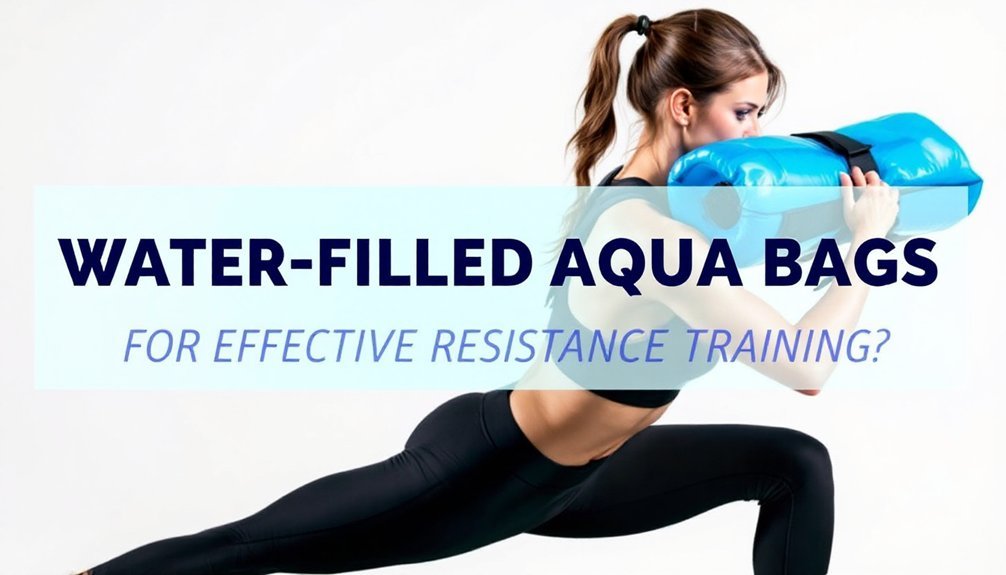
When selecting your perfect aqua bag, you'll need to evaluate both size and weight options, which range from the beginner-friendly Cube 7 to the advanced Tank 20 model. The shape of your aqua bag matters greatly, with Tank models being ideal for barbell-style exercises while the Cube and Boba designs work best for kettlebell movements. Additionally, consider how the constant motion of water can help improve your core stability during workouts. Your choice should also factor in handle types, as Cube 7 and Boba 13 feature two side handles, while Tank models offer both internal and external grip options for varied workout styles. Consider your fitness goals carefully, as aqua bags are excellent for developing stability and coordination through the constant motion of water inside the bag.
Size and Weight Options
Selecting the perfect aqua bag depends on your fitness goals, available space, and experience level. With size variations ranging from 16" to 22" and weight adjustments from 7kg to 20kg, you'll find options suited to different training needs. Aqua bag weights can be easily adjusted by adding or removing water to match your progression.
Consider these key factors when choosing your aqua bag:
- Weight capacity: Confirm your wall or ceiling support can handle the filled weight of your chosen bag
- Space requirements: Larger bags need more room for dynamic movements, while smaller ones offer better portability
- Training focus: Choose lighter weights (7-13kg) for cardio and endurance, or heavier options (15-20kg) for strength training
Shape and Handle Types
The versatility of aqua bags extends beyond their weight capacity to their innovative shapes and handle configurations. Different shapes offer unique shape benefits, with crescent designs perfect for traditional movements and teardrop styles ideal for striking workouts. Handle versatility comes from multiple grip options, allowing you to customize your training approach. The live weight design promotes safer spine alignment during complex movement patterns compared to traditional equipment.
| Shape Type | Handle Style | Best For |
|---|---|---|
| Crescent | Two-handle | Squats, lunges |
| Teardrop | Single-handle | Striking, swings |
| Compound | Internal/External | Full-body workouts |
You'll find that ergonomic designs contour naturally to your body, reducing strain during exercises. The combination of soft, flexible materials and strategic handle placement guarantees comfortable, secure grips for everything from rehabilitation exercises to intense strength training sessions.
Essential Training Techniques
Training effectively with aqua bags requires mastering four fundamental lifting techniques: stable, rhythm, collision, and tilt lifts. Each technique offers unique dynamic stability benefits and resistance variations that target different aspects of strength and control. Using top fitness trackers can help you monitor your performance and progress during these workouts.
Studies show that reactive balance training can reduce falls by up to 60% through controlled movement practice.
Here are three key aspects of mastering aqua bag training:
- Stable lifts focus on keeping water movement minimal while maintaining constant muscle tension.
- Rhythm lifts require you to sync with the water's natural movement patterns.
- Collision and tilt lifts intentionally create water disruption for enhanced power development.
When practicing these techniques, you'll need to engage your core consistently while adapting to the shifting resistance. Start with stable lifts to build foundational control, then progress to more challenging movements as your coordination improves.
Safety and Form Guidelines
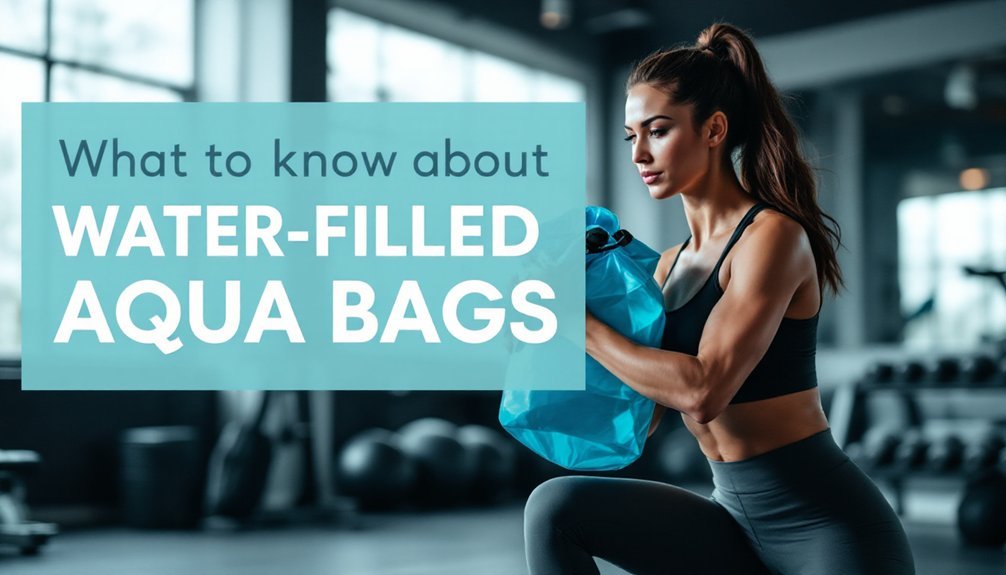
Safe and effective aqua bag workouts depend on proper form and safety protocols that protect both you and your equipment. When using your aqua bag, verify it's securely hung with proper spacing of 3-4 feet between bags in group settings. Don't overfill the bag, as this reduces its reactivity and increases injury risk. The needle punched polypropylene construction ensures maximum durability during intense training sessions. Additionally, incorporating essential cardio equipment into your routine can further enhance your overall fitness experience.
Essential safety tips include regular inspection for damage, proper drainage in controlled environments, and maintaining correct body alignment during exercises. Focus on proper techniques by keeping your wrists neutral and forearms parallel to the floor while exercising. Remember to engage your core during movements, especially during lunges and twists. As water shifts inside the bag, you'll need to adjust your movements to maintain balance and control, making each exercise more challenging and effective.
Building Progressive Workout Programs
When developing an effective aqua bag routine, you'll need a structured approach to progressive overload that gradually challenges your muscles and improves strength. Your workout variations should focus on systematic progression while maintaining proper form and technique.
To create an effective progressive progression plan:
- Start with basic movements at 60% intensity, focusing on proper form and water dynamics
- Increase workout intensity by 5% weekly through added repetitions or more challenging variations
- Include recovery weeks every fourth week, reducing intensity to 50% before resuming progression
Remember to adjust your training based on daily performance factors like sleep and energy levels. Combine different movement patterns such as Calm, Churn, and Crash methods to maintain engagement while steadily building strength and improving reactive stability.
Advanced Training Applications
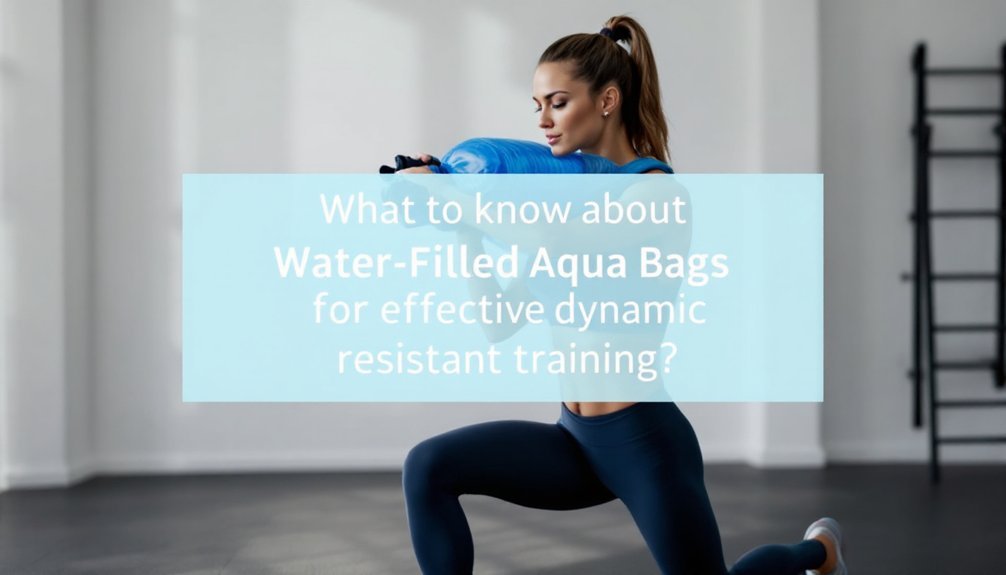
Advanced athletes looking to maximize their fitness potential will find aqua bags particularly effective for complex training protocols. Your training can incorporate dynamic adaptability by manipulating water levels and resistance mechanics through various planes of motion, enhancing both stability and power output.
You'll benefit from advanced techniques like reactive training, which challenges your body's ability to respond to unpredictable forces. By combining multi-directional movements with adjustable instability, you can create sophisticated workout sequences that target specific performance goals. For example, you can progress from basic kettlebell swings to complex flow workouts that incorporate diagonal movements and rotational exercises. The constant water movement forces your stabilizer muscles to work harder, developing functional strength that transfers effectively to real-world athletic performance.
Frequently Asked Questions
How Long Does an Aqua Bag Typically Last Before Needing Replacement?
While you might worry about frequent replacements, your aqua bag's durability can extend up to 10 years with proper care, but watch for replacement indicators like leaks, tears, or shape deformation.
Can Aqua Bags Be Used Effectively in Cold Outdoor Temperatures?
You shouldn't use aqua bags in cold weather due to freezing risks. For outdoor training safety, move your workout indoors when temperatures drop below freezing to prevent dangerous ice formation.
What Cleaning Products Are Safe to Use on Aqua Bags?
Like treating delicate coral reefs, you'll want gentle eco-friendly cleaners and mild disinfectant options. Use natural soaps, vinegar-water solutions, or specialized sports equipment cleaners to maintain your aqua bag's integrity.
Do Aqua Bags Need Special Storage Conditions to Prevent Damage?
Store your aqua bags between 33-100°F in a dry, clean area away from direct sunlight. Don't stack them, keep them off the ground, and check regularly for damage to guarantee longevity.
Can Pool or Salt Water Be Used Instead of Tap Water?
You shouldn't use pool or salt water as they'll compromise your bag's durability. Stick to tap water to maintain water quality and prevent potential damage to the bag's materials.


